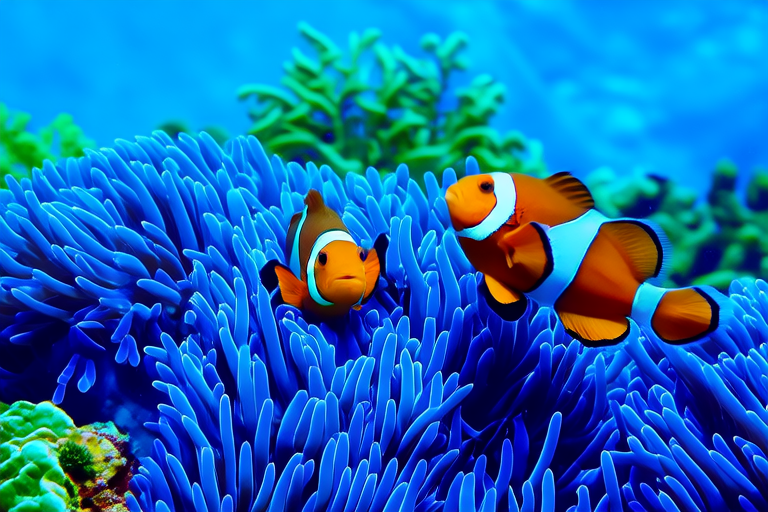Clownfish and Their Symbiotic Relationship with Sea Anemones
Welcome to an exploration of one of the most fascinating relationships in the ocean: the symbiotic bond between clownfish and sea anemones. These colorful, charismatic fish have captured the hearts of many, from children to marine enthusiasts, thanks to their vibrant appearances and intriguing lifestyle. This article delves into the world of clownfish, their natural habitats, and the remarkable partnership they share with sea anemones.
The Clownfish Species and Their Natural Habitat
Clownfish, also known as anemonefish, belong to the family Amphiprioninae, which comprises around 30 species. These small, hardy fish are native to the tropical waters of the Indo-Pacific region, including the Red Sea, the Great Barrier Reef, and the South Pacific Ocean. They are typically found in shallow reefs and lagoons where sea anemones thrive. The warm, clear waters provide ideal conditions for both the clownfish and their anemone hosts.
Clownfish are well-adapted to their environment, with their striking color patterns serving as camouflage against predators. Their vibrant hues range from orange and white to black and yellow, depending on the species. Some of the more popular species include the common clownfish (A. ocellaris), the tomato clownfish (A. frenatus), and the percula clownfish (A. percula).
The Mutualistic Relationship Between Clownfish and Sea Anemones
The relationship between clownfish and sea anemones is a classic example of mutualism, a type of symbiotic interaction where both partners benefit. In this case, the clownfish provides protection for the sea anemone, while the anemone offers shelter and food to the clownfish.
Sea anemones are sessile animals related to jellyfish and corals. They possess tentacles equipped with stinging cells called nematocysts, which they use to capture prey and deter predators. However, clownfish have developed a unique ability to live among these potentially deadly tentacles without being harmed. This protection allows clownfish to take refuge within the anemone, reducing the risk of predation from larger marine creatures.
In return, clownfish help the anemone by driving away potential predators, such as butterflyfish, which feed on anemones. Additionally, clownfish may bring nutrients to the anemone through their waste products and leftover food particles. This mutually beneficial arrangement has evolved over millions of years, resulting in a strong coexistence.
Chemical Signals and Protection from Stings
One of the most intriguing aspects of this relationship is how clownfish manage to avoid the anemone’s stings. Research has revealed that clownfish produce a layer of mucus on their skin that contains specific chemicals. These chemicals interfere with the activation of the anemone’s nematocysts, preventing them from firing when the clownfish comes into contact with the tentacles.
This protective mucus is thought to develop gradually as the clownfish spends time in close proximity to the anemone. Initially, the clownfish may suffer minor stings, but over time, its body adapts by producing the necessary compounds to shield it from further harm. This adaptation process highlights the evolutionary complexity of symbiotic relationships in nature.
Compatibility of Clownfish Species with Different Sea Anemones
Not all clownfish species are compatible with every type of sea anemone. In the wild, certain clownfish species have evolved to form symbiotic relationships with specific anemone species. For instance, the common clownfish (A. ocellaris) often pairs with the magnificent sea anemone (Heteractis magnifica), while the tomato clownfish (A. frenatus) frequently associates with the giant carpet anemone (Stichodactyla gigantea).
When considering clownfish and anemone pairings in home aquariums, it is crucial to research the compatibility of the chosen species. Some anemones may be too aggressive or toxic for certain clownfish species, while others might not provide adequate protection or resources. Aquarists should carefully select species that are known to thrive together in captivity.
Tips for Aquarium Owners
For those looking to recreate the symbiotic relationship between clownfish and sea anemones in a home aquarium, several factors must be considered:
- Water Quality: Maintain optimal water parameters, including temperature, pH, and salinity, to ensure the health of both the clownfish and the anemone.
- Diet: Feed the clownfish a balanced diet of high-quality flake or pellet food, supplemented with occasional live or frozen foods. Ensure the anemone receives sufficient light for photosynthesis.
- Space: Provide ample space for both the clownfish and the anemone to grow and thrive. Overcrowding can lead to stress and aggression.
- Compatibility: Choose clownfish and anemone species that are known to coexist harmoniously in captivity. Avoid introducing incompatible species to prevent potential conflicts.
- Gradual Introduction: Introduce the clownfish to the anemone gradually, allowing time for the fish to acclimate to the presence of the anemone. This approach helps minimize stress and promotes a successful symbiotic relationship.
By following these guidelines, aquarium owners can create a thriving environment for their clownfish and anemone, fostering a beautiful and educational display of marine life.
The Importance of Marine Biodiversity
The symbiotic relationship between clownfish and sea anemones serves as a powerful reminder of the intricate web of life in our oceans. Each species plays a vital role in maintaining the balance of marine ecosystems, and the loss of even one component can have far-reaching consequences.
As human activities continue to impact marine environments, it is essential to prioritize conservation efforts and promote sustainable practices. By protecting marine biodiversity, we safeguard not only the survival of individual species but also the health and resilience of entire ecosystems. This includes supporting initiatives aimed at preserving coral reefs, which serve as habitats for countless species, including clownfish and their anemone hosts.
The study of symbiotic relationships like that between clownfish and sea anemones offers valuable insights into the complexities of life in the ocean. It underscores the importance of preserving these delicate balances and encourages us to act as stewards of our planet’s precious marine resources.
